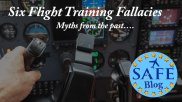 Our daily lives are determined by habits. We see the world through stereotypes and operate on scripts generated from our values and historical experiences. These “cultural influences” are notoriously hard to change.
Our daily lives are determined by habits. We see the world through stereotypes and operate on scripts generated from our values and historical experiences. These “cultural influences” are notoriously hard to change.

Similarly, larger institutional endeavors, like flight training, become frozen in “the way we have always done it,” without a fresh view of the entire process from first principles. How would we arrange flight training if we approached it as a “clean sheet?” We seldom have the opportunity or motivation to examine these implicit “guiding rules” that control our lives. We complain about problems like efficiency and safety when our systems may actually be the cause.

The current “FAA 141 modernization” initiative is an opportunity to think creatively about *all* flight training and change some really stupid procedures we have unfortunately accepted as essential. ” Why do we teach pilots stalls (and terrify them) before we teach rudder control?” “Why do we organize courses: PPL (VFR), then IFR, then Commercial (back to VFR)?” “Are the 10 hours of ‘Commercial Complex’ of any use at all?” “With LOC as the primary fatal accident cause, wouldn’t greater skill training in basic maneuvering be a better focus?”
If you could wave a magic wand and change how we teach flying, what changes would *you* make? Here are some essential modifications that would instantly improve flight training and result in more effective learning, a reduced drop-out rate, and safer, more confident pilots.
Move Initial Stall Training After Ground Reference!
If you look at the sequence of maneuvers in most Private Pilot Syllabi, the order of introduction is totally opposed to the FAA “building block” theory. Why do we teach stalls, which require accurate rudder control for success, before learners are comfortable in the plane and have mastered rudder control? Learners experiencing stalls too early (usually on Lesson Three) are not yet even comfortable in flight and certainly can’t use the rudder effectively. Yet we subject them to stalls (with predictable results) and terrify them. No learning occurs with extreme fear, and many people end up quitting training as a result. Wouldn’t it make more sense to teach ground reference (adding the vertical aspect of “patterns in the sky”) *BEFORE* we teach stalls? There are no skills in ground reference that require stalls; these blocks of training are easily interchangeable.
 Look at the initial 1940s Civilian Pilot Training which had stalls way back in Lesson 11. Someone reordered this sequence and it unfortunately became “institutionalized!” The only modern syllabus with this sensible organization is the King Schools Private Syllabus. Their syllabus requires mastery of climbing and descending turns before introducing stalls on Lesson 6. All syllabi should be similarly constructed with ground reference (and climbing and descending turns) *BEFORE* stalls. Every independent CFI or school that has reordered their training in this manner reports much better student retention and skill development; no student stall PTSD. After learners are more comfortable, confident, and fly coordinated – their stall experience is not terrifying. Actual learning occurs in this phase of flight and pilots exhibit faster and more comprehensive learning.
Look at the initial 1940s Civilian Pilot Training which had stalls way back in Lesson 11. Someone reordered this sequence and it unfortunately became “institutionalized!” The only modern syllabus with this sensible organization is the King Schools Private Syllabus. Their syllabus requires mastery of climbing and descending turns before introducing stalls on Lesson 6. All syllabi should be similarly constructed with ground reference (and climbing and descending turns) *BEFORE* stalls. Every independent CFI or school that has reordered their training in this manner reports much better student retention and skill development; no student stall PTSD. After learners are more comfortable, confident, and fly coordinated – their stall experience is not terrifying. Actual learning occurs in this phase of flight and pilots exhibit faster and more comprehensive learning.
Since most pilots already have (useless) “complex,” teach “Extended Envelope” Instead!
 The current Commercial Pilot’s “complex training” in 61.129 is a useless joke. Most learners in modern flight schools already have 10 hours “complex time” (glass-panel airplanes w/autopilot). The current “complex training” requirement adds *NOTHING* to their skills! “Real complex” airplanes with retractable gear, and constant speed props were eliminated after the ERAU Arrow accident. I remember talking with AFS-800 at Sun ‘N Fun in 2018 about this impending change. “Commercial training” as it now exists is unfortunately just “Private Pilot 2.0!”
The current Commercial Pilot’s “complex training” in 61.129 is a useless joke. Most learners in modern flight schools already have 10 hours “complex time” (glass-panel airplanes w/autopilot). The current “complex training” requirement adds *NOTHING* to their skills! “Real complex” airplanes with retractable gear, and constant speed props were eliminated after the ERAU Arrow accident. I remember talking with AFS-800 at Sun ‘N Fun in 2018 about this impending change. “Commercial training” as it now exists is unfortunately just “Private Pilot 2.0!”

These learners should be acquiring a higher level of VFR skills – as was originally intended. This should include “eyes outside, yank and bank” training. I suggest advanced control skills such as SAFE’s “Extended Envelope Maneuvers.“These are required for airline pilots under CFR Part 121.423 with every recurrent training. This program would immediately increase commercial pilot skill, confidence, and safety. It would also prepare them for the commercial maneuvers like chandelles and lazy eights that follow. This training could hypothetically be combined with some UPRT training or tailwheel for comprehensive aircraft control. But there is no benefit at all to the current “complex training” as it is practiced; we are missing an important opportunity to address the LOC safety problem.

Most private pilots cannot perform coordinated climbing turns left and right. Consequently, 89.3% of pattern stalls are on take-off and turn out. LOC is a problem because pilots only experience 10% of the flight training envelope (what a missed opportunity). I developed the EET maneuvers as a “detox” for instrument training. 40-50 hours of IFR training with gentle turns and eyes inside made commercial training a challenge.
Commercial After Private (Higher level VFR) *Then* IFR
It makes no sense to go from Private (maneuvering eyes outside), followed by Instrument (eyes totally inside and gentle control usage), then back to outside reference (Commercial)? The only reason for this goofy organization is the FAA requirement for 250 (190 in 141) total hours for certification. This change would require regulation changes to avoid high costs of hour-building. Military training proceeds in this sensible manner. Their VFR proceeds to an advanced level before instrument is integrated and *all* pilots become “all-weather” capable. In civilian training instrument was added after private for recreational pilots not continuing their training. In academy flight training programs the IFR provides the extra hours required for commercial certification.
Historically, a flight instructor certificate did not require an instrument rating. Pilots seeking a professional career trained private, commercial, and CFI (IFR was added later). All initial training was consistently “eyes outside VFR;” which made real sense.
Eliminate “Performing the Duties of Pilot In Command!”

PDPIC is the most damaging capitulation the FAA has ever succumbed to. Allowing “solo time” to be flown with an instructor in the right seat eliminates all the benefits of these essential character-building requirements. This leads to CFIs graduating with only 10 hours of “real solo” and a total lack of confidence and command authority in these pilots. Many large flight schools will not even allow their CFIs to fly solo to ferry planes. Nothing builds resilience and self-efficacy like a well-prepared learner flying real solo time; meeting and overcoming real challenges.
This lowered bar of challenge encourages bottom-feeder flight schools to send poorly-prepared learners to accomplish these events without proper preparation. The standard should be “Would you send this pilot (real) SOLO – without the warm fuzzy in the right seat – on a 300nm X-C (or is this really a “crew mission?”) Combining PDPIC with the lack of “real complex” flight training has made the commercial pilot certificate “Private Pilot 2.0.” We can do a lot better (and make superior, safer pilots) with some thoughtful changes. Every school and professional CFI can insist on a higher standard for safer pilots.. Fly safely out there (and often)!


Pictures from SAFE Sun ‘N Fun HERE. Please participate (and win) the SAFE Spring Sweepstakes. Get a chance by joining, upgrading to “sustaining” membership, or just donating $15 to our SAFE CFI Scholarship.
Win a $1,200 Lightspeed “Delta Zulu” headset, an Aerox O2 system or a Sporty’s PJ2 handheld radio!



